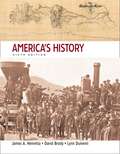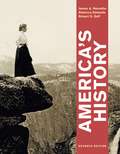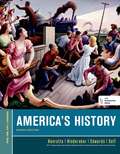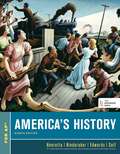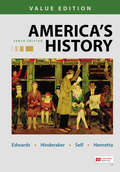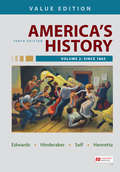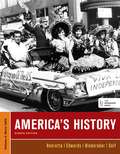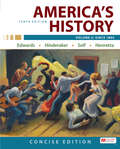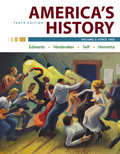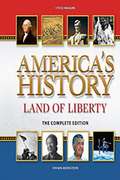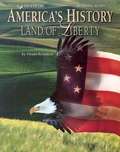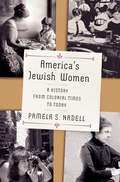- Table View
- List View
America's Great War: World War I and the American Experience (Critical Issues In American History)
by Robert H. ZiegerRecent bestsellers by Niall Ferguson and John Keegan have created tremendous popular interest in World War I. In America's Great War prominent historian Robert H. Zieger examines the causes, prosecution, and legacy of this bloody conflict from a frequently overlooked perspective, that of American involvement. <p><p> This is the first book to illuminate both America's dramatic influence on the war and the war's considerable impact upon our nation. Zieger's engaging narrative provides vivid descriptions of the famous battles and diplomatic maneuvering, while also chronicling America's rise to prominence within the postwar world. On the domestic front, Zieger details how the war forever altered American politics and society by creating the National Security State, generating powerful new instruments of social control, bringing about innovative labor and social welfare programs, and redefining civil liberties and race relations. America's Great War promises to become the definitive history of America and World War I.
America's Hidden History
by Kenneth C. DavisKenneth C. Davis, author of the phenomenal New York Times bestseller Don't Know Much About History, presents a collection of extraordinary stories, each detailing an overlooked episode that shaped the nation's destiny and character. Davis's dramatic narratives set the record straight, busting myths and bringing to light little-known but fascinating facts from a time when the nation's fate hung in the balance. Spanning a period from the Spanish arrival in America to George Washington's inauguration in 1789, America's Hidden History details these episodes, among others: The story of the first real Pilgrims in America, who were wine-making French Huguenots, not dour English Separatists The coming-of-age story of Queen Isabella, who suggested that Columbus pack the moving mess hall of pigs that may have spread disease to many Native Americans The long, bloody relationship between the Pilgrims and Indians that runs counter to the idyllic scene of the Thanksgiving feast The little-known story of George Washington as a headstrong young soldier who committed a war crime, signed a confession, and started a war! Full of color, intrigue, and human interest, America's Hidden History is an iconoclastic look at America's past, connecting some of the dots between history and today's headlines, proving why Davis is truly America's Teacher.
America's History
by James A. Henretta Lynn Dumenil David BrodyIn order for students to succeed in an AP U. S. history course, they need to understand not only what happened, but also why it happened. "America's History" has long been praised as a text that helps students to think critically about history and analyze both how and why historical events have occurred. "America's History" deftly weaves together political, social, and cultural history in a narrative that students find accessible and engaging. Exceptional pedagogical support -- overviews, maps, figures, illustrations, and embedded documents -- are carefully integrated to encourage the development of students' historical skills. "America's History" is the text that covers not only the facts, but also the skills that students need to have success in the AP U. S. history course. Need help with the audit? Click here to download an AP correlation.
America's History (7th Edition)
by James A. Henretta Rebecca Edwards Robert O. SelfAmerica's History helps students understand the world in which we live, by drawing links between events in the United States and those elsewhere.
America's History (Eighth Edition): Volume One: To 1877
by James A. Henretta Rebecca Edwards Robert O. SelfKnown for its interpretive voice and thoughtful analysis, America's History models exactly the kind of thinking and writing students need to be successful. An accessible and balanced narrative with built-in primary sources and skills-based pedagogy gives students practice in thinking historically, and features new ways of mastering the content so that students come to class prepared. The eighth edition rolls out Bedford/St. Martin's new digital history tools, including LearningCurve, an adaptive quizzing engine that garners over a 90% student satisfaction rate, and LaunchPad, the all new interactive e-book and course space that puts high quality easy-to-use assessment at your fingertips. Easy to integrate into your campus LMS, and featuring video, additional primary sources, a wealth of adaptive and summative quizzing, and more, LaunchPad cements student understanding of the text while helping them make progress toward learning outcomes. It's the best content joined up with the best technology.
America's History for the AP Course
by James A. Henretta Rebecca Edwards Robert O. Self Eric HinderakerAmerica's History offers a thematic approach and skills-oriented pedagogy that helps students succeed in the redesigned AP U. S. History course. Known for its attention to AP themes and content, the new edition features a new nine part structure closely aligned with the chronology of the new AP U. S. History course, an expanded documents program, LearningCurve--an online adaptive learning tool that reinforces students' reading--and a wealth of supporting resources and digital options that give teachers and students the tools they need to master the course and the new exam. View a sample chapter. *AP is a trademark registered and/or owned by the College Board, which was not involved in the production of, and does not endorse, this product.
America's History for the AP® Course
by James A. Henretta Rebecca Edwards Eric HinderakerAmerica's History offers a thematic approach and skills-oriented pedagogy that helps students succeed in the redesigned AP U.S. History course. Known for its attention to AP themes and content, the new edition features a new nine part structure closely aligned with the chronology of the new AP U.S. History course, an expanded documents program, LearningCurve--an online adaptive learning tool that reinforces students' reading--and a wealth of supporting resources and digital options that give teachers and students the tools they need to master the course and the new exam.
America's History for the AP® Course
by Rebecca Edwards Eric Hinderaker James Henretta Robert SelfNIMAC-sourced textbook
America's History, Sixth Edition
by James A. Henretta Lynn Dumenil David BrodyHigh School AP U.S. history textbook
America's History, Value Edition, Combined Volume: 2 Books Set
by Rebecca Edwards Eric Hinderaker James Henretta Robert SelfAmerica’s History explains WHY events occurred, not just when. Students are provided an analytical and big-picture approach to American history in an affordable format.
America's History, Value Edition, Volume 1: 2 Books Set
by Rebecca Edwards Eric Hinderaker James Henretta Robert SelfAmerica’s History explains WHY events occurred, not just when. Students are provided an analytical and big-picture approach to American history in an affordable format.
America's History, Value Edition, Volume 2: 2 Books Set
by Rebecca Edwards Eric Hinderaker James Henretta Robert SelfAmerica’s History explains WHY events occurred, not just when. Students are provided an analytical and big-picture approach to American history in an affordable format.
America's History, Vol II (Eighth Edition)
by James A. Henretta Rebecca Edwards Robert O. SelfHelp your students think historically Known for its interpretive voice and thoughtful analysis, America's History models exactly the kind of thinking and writing students need to be successful. An accessible and balanced narrative with built-in primary sources and skills-based pedagogy gives students practice in thinking historically, and features new ways of mastering the content so that students come to class prepared.
America's History, Volume 1
by Rebecca Edwards Eric Hinderaker James Henretta Robert SelfAmerica’s History explains WHY events occurred, not just when. Students are provided an analytical and big-picture approach to American history with a plethora of support tools to help determine what’s most important.
America's History, Volume 1: Concise Edition
by James A. Henretta Rebecca Edwards Robert O. Self Eric HinderakerAmerica�s History explains WHY events occurred, not just when. Students are provided an analytical and big-picture approach to American history with a plethora of support tools.
America's History, Volume 2: Concise Edition
by James A. Henretta Rebecca Edwards Robert O. Self Eric HinderakerAmerica�s History explains WHY events occurred, not just when. Students are provided an analytical and big-picture approach to American history with a plethora of support tools.
America's History, Volume 2: To 1877
by Rebecca Edwards Eric Hinderaker James Henretta Robert SelfAmerica’s History explains WHY events occurred, not just when. Students are provided an analytical and big-picture approach to American history with a plethora of support tools to help determine what’s most important.
America's History: Land of Liberty
by John L. Esposito Vivian Bernstein Steck-Vaughn Staff Mel MillerAs you go through this book, you will discover how people created a new nation in North America that was different from any other country. Every chapter starts with statements made to encourage readers in the units and chapters. There are questions presented at the beginning of every chapter that help students to focus on the main ideas throughout the book.
America's History: Land of Liberty
by Vivian BernsteinAmerica's early Years, From Colonies to a Nation, The Nation grows and Changes, The Civil War and Reconstruction, The United States becomes an Industrial Nation, The United States as a World Power, The Great Depression and World War II, The Years after World War II, The United States Today and Tomorrow.
America's History: Land of Liberty, Beginning to 1877
by Vivian BernsteinAs you read America's History: Land of Liberty, you will discover how people created a new nation in North America that was different from any other country. That nation, the United States of America, was the only nation at the end of the 1700s where people made their own laws and ruled themselves without a king or queen. It was a great experiment because no one knew if a nation with such a government could survive. You will learn how the new nation not only survived, but grew larger and stronger.
America's Imagined Revolution: The Historical Novel of Reconstruction (Southern Literary Studies)
by Tomos Wallbank-HughesAmerica’s Imagined Revolution explores the Reconstruction period after the Civil War to ask narratological, historiographical, and theoretical questions about how slave emancipation has (and has not) been theorized as revolution. Reading historical fiction by authors such as George Washington Cable, Albion Tourgée, Charles Chesnutt, Frances Harper, and W. E. B. Du Bois in dialogue with nineteenth-century historical writing—and the era’s legal, political, and print culture—Tomos Wallbank-Hughes excavates an evanescent form of historicist writing sensitive to the revolutionary changes that shaped life in the emancipation-era South.As an aesthetic form, the historical novel of Reconstruction poses questions about revolutionary experience in plantation societies, and in the process challenges critical assumptions about historical time in the nineteenth century: How do authors narrate epochal change that also feels like retrenchment? In what direction does history travel if it does not progress? What narratives of race, class, and region encompass both continued domination and ruptured power? By plumbing the situations that give it form, the historical novel of Reconstruction provides a window into the literary culture of the South’s long nineteenth century in which, rather than a storehouse of tradition, the region became a terrain for interpreting social revolution and uncovering slavery’s revolutionary afterlives.America’s Imagined Revolution offers a new interpretation of the literary and historiographical significance of the Reconstruction period and its relationship to American literary history.
America's Inadvertent Empire
by William E. Odom Robert DujarricThe United States finds itself at the center of an empire of a new type, wealth-generating and voluntary, not a traditional imperial system, say the authors of this compelling book. William E. Odom and Robert Dujarric examine America's unprecedented power within the international arenas of politics, economics, demographics, education, science, and culture. They argue persuasively that the major threat to this unique empire is ineffective U. S. leadership, not a rising rival power center. America cannot simply behave as an ordinary sovereign state, Odom and Dujarric contend. They describe the responsibilities that accompany staggering power advantages, and they explain that resorting to unilateralism makes sense only when it becomes necessary to overcome paralysis in multilateral organizations. The authors also offer insights into the importance of liberal international institutions as a source of power, why international cooperation pays, and why spreading democracy often inhibits the spread of constitutional order. If the United States uses its own power constructively, the authors conclude, the American empire will flourish for a long time. Book jacket.
America's Japan and Japan's Performing Arts: Cultural Mobility and Exchange in New York, 1952-2011
by Barbara E. ThornburyAmerica’s Japan and Japan’s Performing Arts studies the images and myths that have shaped the reception of Japan-related theater, music, and dance in the United States since the 1950s. Soon after World War II, visits by Japanese performing artists to the United States emerged as a significant category of American cultural-exchange initiatives aimed at helping establish and build friendly ties with Japan. Barbara E. Thornbury explores how “Japan” and “Japanese culture” have been constructed, reconstructed, and transformed in response to the hundreds of productions that have taken place over the past sixty years in New York, the main entry point and defining cultural nexus in the United States for the global touring market in the performing arts. Thornbury crosses disciplinary boundaries in her wide range of both primary sources and published scholarship, making the book of interest to students and scholars of performing arts studies, Japanese studies, and cultural studies.
America's Jewish Women: A History From Colonial Times To Today
by Pamela NadellA groundbreaking history of how Jewish women maintained their identity and influenced social activism as they wrote themselves into American history. What does it mean to be a Jewish woman in America? In a gripping historical narrative, Pamela S. Nadell weaves together the stories of a diverse group of extraordinary people—from the colonial-era matriarch Grace Nathan and her great-granddaughter, poet Emma Lazarus, to labor organizer Bessie Hillman and the great justice Ruth Bader Ginsburg, to scores of other activists, workers, wives, and mothers who helped carve out a Jewish American identity. The twin threads binding these women together, she argues, are a strong sense of self and a resolute commitment to making the world a better place. Nadell recounts how Jewish women have been at the forefront of causes for centuries, fighting for suffrage, trade unions, civil rights, and feminism, and hoisting banners for Jewish rights around the world. Informed by shared values of America’s founding and Jewish identity, these women’s lives have left deep footprints in the history of the nation they call home.
America's Journey: Continuity and Change in the Twentieth Century
by David Goldfield Carl Abbott Virginia Dejohn Anderson Jo Ann E. Argersinger Peter H. Argersinger William L. Barney Robert M. WeirA number of features in this book are designed to aid in the study of history. Each chapter begins with Questions, organized by the main subtopics of each chapter, that encourage careful consideration of important themes and developments.


